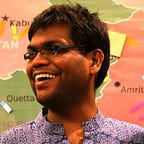Here come the young
(An edited version of this article was first published by The Hindu Business Line.)
The art world can be painful to navigate, especially for young artists from small towns. They are not plugged into social circles that make it easy to be spotted by gallerists, curators and art dealers. The CIMA Art Mela at the Nehru Centre Art Gallery in Worli, Mumbai, from January 23 to 26, was an effort to see value in what they produce, and give them a platform.
The Centre of International Modern Art (CIMA) has organized this mela in Kolkata and Delhi for 10 years. They brought it to Mumbai in 2020. Many of the young artists whose works were on sale were discovered via the CIMA Award, a biennial initiative to recognize excellence in painting, sculpture, graphic art, video art, digital art, and installation art. It is open to self-taught artists, and not only those who have graduated from art schools.
“Bridging the gap between urban and rural India is a priority for us, so we spread the word about the award as widely as possible when we seek applications. The jury finds gems from all corners of the country, and maintains quality control. At the mela, we encourage young people who want to buy art but find it unaffordable. We ignite their interest, engage with their sensibilities, and bring art within their reach,” said Rakhi Sarkar, Director of CIMA.
The mela in Mumbai had a huge variety of works on display in a small space, so there were no captions, wall texts or artist biographies to support audiences curious to learn about their background, choice of medium and artistic process. However, this ensured that they had direct contact with the art, unencumbered by the language of the expert that can be alienating for people without a background in art history. Interacting with audiences could have been an exciting opportunity for the young artists but flying them in from all over India would have been financially unsustainable for CIMA.
One of the participating artists was Ganesh Das (37), raised in Murshidabad, West Bengal. He earned his BFA in Painting from the Government College of Art and Craft in Kolkata, and his MFA in Painting from Jamia Millia Islamia University in Delhi. Over a phone call, he said, “My imagination owes a lot to my memories from childhood, and an exposure to mythology was a large part of it. Today, when I make art, I go back to those traditional images and interpret them in my own way for a contemporary audience.”
His untitled works disrupt the gendered associations that mythical narratives cultivate in us through years of conditioning. Even as they reference elements of religious iconography that are easily identifiable in popular culture, their visual language is far from sterile. They are fabulously queer in the way they transgress conventional boundaries between the sacred and the sexual. They tease the viewer with a luscious pomegranate here, a humongous banana there, using food to evoke plenitude and desire.
“Instead of fixing a particular meaning for each work of mine, I leave it open for the viewer to come in and make sense on their own terms,” said Das. To him, creativity, love and sexuality are all various forms of the same energy that courses through the entire universe. The presence of birds and animals speaks to the affinity of humans with other sentient beings; they are part of nature, not outside it. Some of the human figures have attributes of other species, such as the occasional tail or a tongue that stretches up to the thigh.
Another artist participating in the show was Tsering Negi (32) from Kinnaur in Himachal Pradesh. This talented printmaker completed his BFA in Graphics at the Government College of Art in Chandigarh, and his MFA in Graphics at Visva Bharati University in Santiniketan. He has a profound connection with the place he grew up in, and the people of that land appear in his creations. Some of his lithographs were on display at the mela, and the most striking was a work titled ‘Abstraction in Construction’.
“Standing in front of the conglomeration of buildings, there stands a figure adapting well to his environs. This work is a commentary on the haphazard and rapid urbanisation that I am witness to, where all constructions — big or small — take a shape that leads to a visual abstraction of the concrete. Also, it reflects on the abstraction of longing of the open fields I left behind, due to pressing circumstances,” he said over email. Though nature is his muse, his works are not purely representational. Mountains, skies and urban landscapes are imbued with emotions, cultural motifs, and allusions to his Buddhist heritage.
Obayya (39) from Puttur in Karnataka was another participating artist whose works were refreshingly luminous. He earned his BFA from Chamarajendra Academy of Visual Arts in Mysore, and his MFA from Rabindra Bharati University in Kolkata. His fascination with crowds is evident in his treatment of subjects as diverse as dabbawalas on the streets of Mumbai, a group photograph in a classroom, and passengers on a long-distance train. His favourite medium is acrylic, and his use of colour is evocative.
“I am from a small place with few people. When I moved to big cities, the first thing I noticed was that they were hugely populated. Even if you step out for a cup of tea, there are always a lot of people around,” said Obayya, over a phone call. In his works, individuals merge into an anonymous mass, immersed in hyperlocal experiences that create a sense of community but one that is provisional. They come and they go; pausing, gathering, dispersing — always in a state of flux, inching towards an elsewhere.
